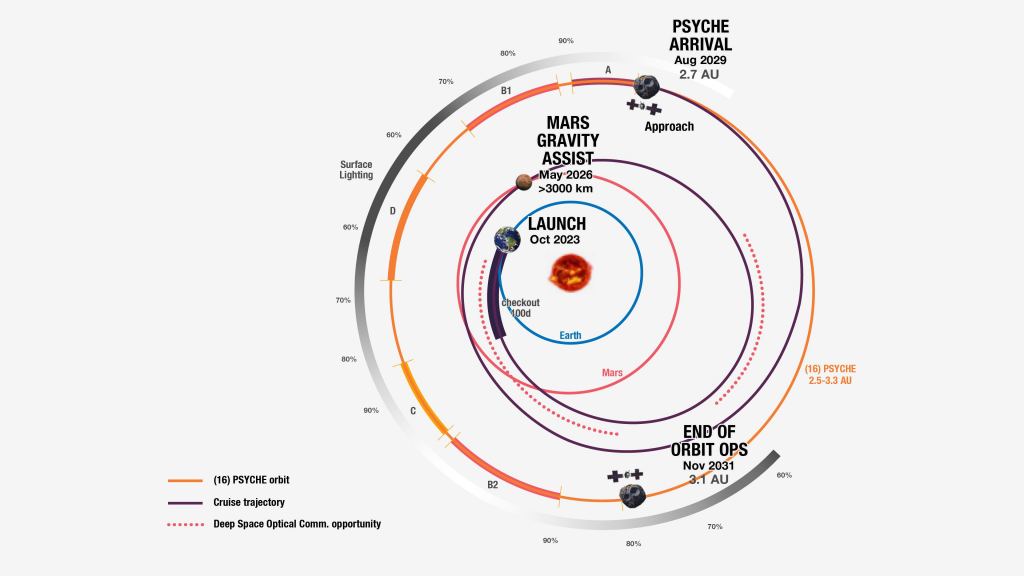On October 13th, at 10:19 AM Eastern (07:19 AM Pacific), NASA’s Psyche mission successfully launched atop a SpaceX Falcon Heavy rocket from Launch Pad 39A at NASA’s Kennedy Space Center in Florida. This spacecraft is now on its way to rendezvous with the M-type asteroid of the same name, an object in the Main Asteroid Belt almost entirely composed of metal. This metallic asteroid is thought to be the remnant of a planetoid that lost its outer layers, leaving behind a core of iron-nickel and precious metals. By studying this object, scientists hope to learn more about the formation of rocky planets.
About five minutes after liftoff, the fairings on the rocket’s second stage separated and the first stage boosters, which descended back to Earth. Roughly an hour into the flight, the payload separated from the second stage and reached orbit. The Psyche spacecraft then entered safe mode while ground controllers waited to acquire a signal from the spacecraft. By 11:50 AM Eastern (08:50 AM Pacific), Psyche established two-way communications with NASA’s Deep Space Network (DSN) complex, and initial telemetry reports showed the spacecraft was in good health.
As Lindy Elkins-Tanton, principal investigator of the Psyche mission at Arizona State University (ASU), stated:
“We said ‘goodbye’ to our spacecraft, the center of so many work lives for so many years – thousands of people and a decade. But it’s really not a finish line; it’s a starting line for the next marathon. Our spacecraft is off to meet our asteroid, and we’ll fill another gap in our knowledge – and color in another kind of world in our solar system.”
The first 100 days of the mission will be the initial checkout period, where mission controllers will test all of the flight systems to ensure they are in working order. A key part of this phase is testing the solar electric propulsion (SEP) system, an ionic propulsion method powered by solar power. This extremely fuel-efficient system relies on electromagnetic fields to charge neutral gas atoms and accelerate them to create thrust. Before the mission can depart, mission controllers need to know that the electric thrusters are ready to continuously fire over long stretches of the trajectory.
Psyche‘s flight path will take it past Mars in May 2026, giving it a gravity assist maneuver and allowing it to rendezvous with Pysche in the Main Asteroid Belt by August 2029. Once there, it will enter orbit around the e 279-km-wide (173 mi) asteroid and commence its 26-month-long science investigation. The flight will take six years and will see the spacecraft traverse a distance of 3.6 billion km (2.2 billion mi), or 24 Astronomical Units (AUs) – the distance between the Earth and the Sun. Said NASA Administrator Bill Nelson after the successful launch:
“Congratulations to the Psyche team on a successful launch, the first journey to a metal-rich asteroid. The Psyche mission could provide humanity with new information about planet formation while testing technology that can be used on future NASA missions. As Asteroid Autumn continues, so does NASA’s commitment to exploring the unknown and inspiring the world through discovery.”

Once in orbit, Psyche will examine the metallic asteroid using a cutting-edge suite of scientific instruments, including a magnetometer, a gamma-ray and neutron spectrometer, and a multispectral imager. These instruments will undergo a series of checks in about six weeks while the imager acquires its first images to calibrate itself, targeting standard stars and a star cluster with different filters at various exposures. Then, the Psyche team will activate an automatic feed to a publicly viewable website where people can view raw images acquired during the mission.
The spacecraft is also carrying an experiment on board, a deep space laser communications demonstrator called the Deep Space Optical Communications (DSOC) instrument. This demonstrator will test optical communications technology that can provide future missions with more bandwidth to transmit data than traditional radio frequency communications. Mission controllers expect the first opportunity to activate and test the optical communications system in about three weeks when Psyche will be roughly 7.5 million km (4.7 million mi) from Earth. Said Dr. Prasun Desai, the acting associate administrator at NASA’s Space Technology Mission Directorate (STMD):
“Launching with Psyche is an ideal platform to demonstrate NASA’s optical communications goal to get high-bandwidth data into deep space. It’s exciting to know that, in a few short weeks, Deep Space Optical Communications will begin sending data back to Earth to test this critical capability for the future of space exploration. The insights we learn will help us advance these innovative new technologies and, ultimately, pursue bolder goals in space.”
This will be the first time NASA has tested high-bandwidth, high-data-rate optical communications beyond the Moon. These technologies will enable Psyche to obtain volumes of data (images, spectra, and magnetic readings) that will reveal much about Psyche‘s composition. “I am excited to see the treasure trove of science Psyche will unlock as NASA’s first mission to a metal world,” said associate administrator Nicola Fox of the Space Mission Directorate at NASA HQ. “By studying asteroid Psyche, we hope to better understand our universe and our place in it, especially regarding the mysterious and impossible-to-reach metal core of our own home planet, Earth.”
Further Reading: NASA
The post NASA's Psyche Mission is off to Asteroid Psyche appeared first on Universe Today.
No comments:
Post a Comment